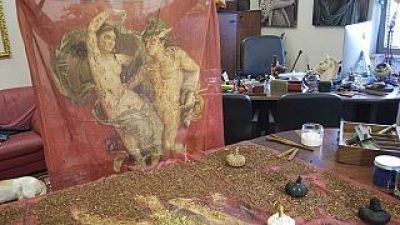Inside the Pompeii archaeological site, a new project is reviving ancient textile dyeing techniques to show another side of daily life before the city was destroyed by the eruption of Mount Vesuvius in A.D. 79. The inspiration for this endeavor stems from frescoes discovered within the archaeological site depicting winged cupids dyeing cloth, harvesting grapes for wine, and crafting perfumes. Describing the connection between the frescoes and reality, Gabriel Zuchtriegel, the director of the archaeological site, remarked, "It is very close to the actual reality." For Zuchtriegel, textile dyeing is another way to bring Pompeii back to life for modern visitors. “It is part of a scientific and cultural project to create awareness that history is not only the big monuments and beautiful paintings,” he said. “There’s also another history, of the economy, the daily life, the lives of the majority which often are not represented in the great narratives.” To bring this project to fruition, Zuchtriegel enlisted the expertise of Claudio Cutuli, one of the world's few remaining master dyers. Cutuli utilizes dyes derived from plants in his own Pompeii-inspired clothing line. Garden historian Maurizio Bartolini said that roots, bark, and flowers were often used in dyeing. Rosehip, for example, made a soft pink “that was one of the most used colors,’ he said. Frescoes in the archaeological site show wealthy Pompeiians dressed brightly in purple, green, pink, blue, and yellow. The hues were achieved by boiling the dyed textiles in metal-lined vats at workshops.
Attualmente è iniziato un nuovo progetto a Pompei. Gli archeologi hanno iniziato a far rivivere antiche tecniche di tintura dei tessuti per mostrare un altro aspetto della vita quotidiana prima che la città fu distrutta dall'eruzione del Vesuvio nel 79 d.C. L'ispirazione per questo progetto è iniziata quando hanno trovato degli affreschi che mostravano il processo di tintura dei tessuti. Gabriel Zuchtriegel, il direttore archeologico di Pompeii, ha detto che questi affreschi sono tecniche molto simili a quelle che facciamo oggi. Secondo lui, continuando questo processo, si può far rivivere una vita antica per i turisti di Pompei. Ha anche spiegato che è importante formare la consapevolezza che Pompei è molto più di quello che vediamo scavato, ma c'è anche la storia, l'economia e la vita quotidiana di queste persone e la loro storia non è sempre raccontata né scritta. Zuchtriegel sta lavorando con Claudio Cutuli, uno degli esperti nella tintura dei tessuti. Cutuli utilizza la tintura di alcune piante nei suoi modelli di abbigliamento ispirati a Pompei. Maurizio Bartolini, storico dei giardini, ha spiegato che le radici, la corteccia degli alberi e i fiori vengono utilizzati molte volte per produrre tinture. Ad esempio, ha spiegato che una pianta chiamata rosa canina è usata per creare il colore rosa nei tempi antichi e anche oggi. Gli affreschi di Pompei mostrano che i cittadini di Pompei portavano abiti tinti di viola, verde, rosa, blu e giallo. Per cambiare le sfumature dei colori, i cittadini di Pompei forse facevano bollire i tessuti già tinti.



